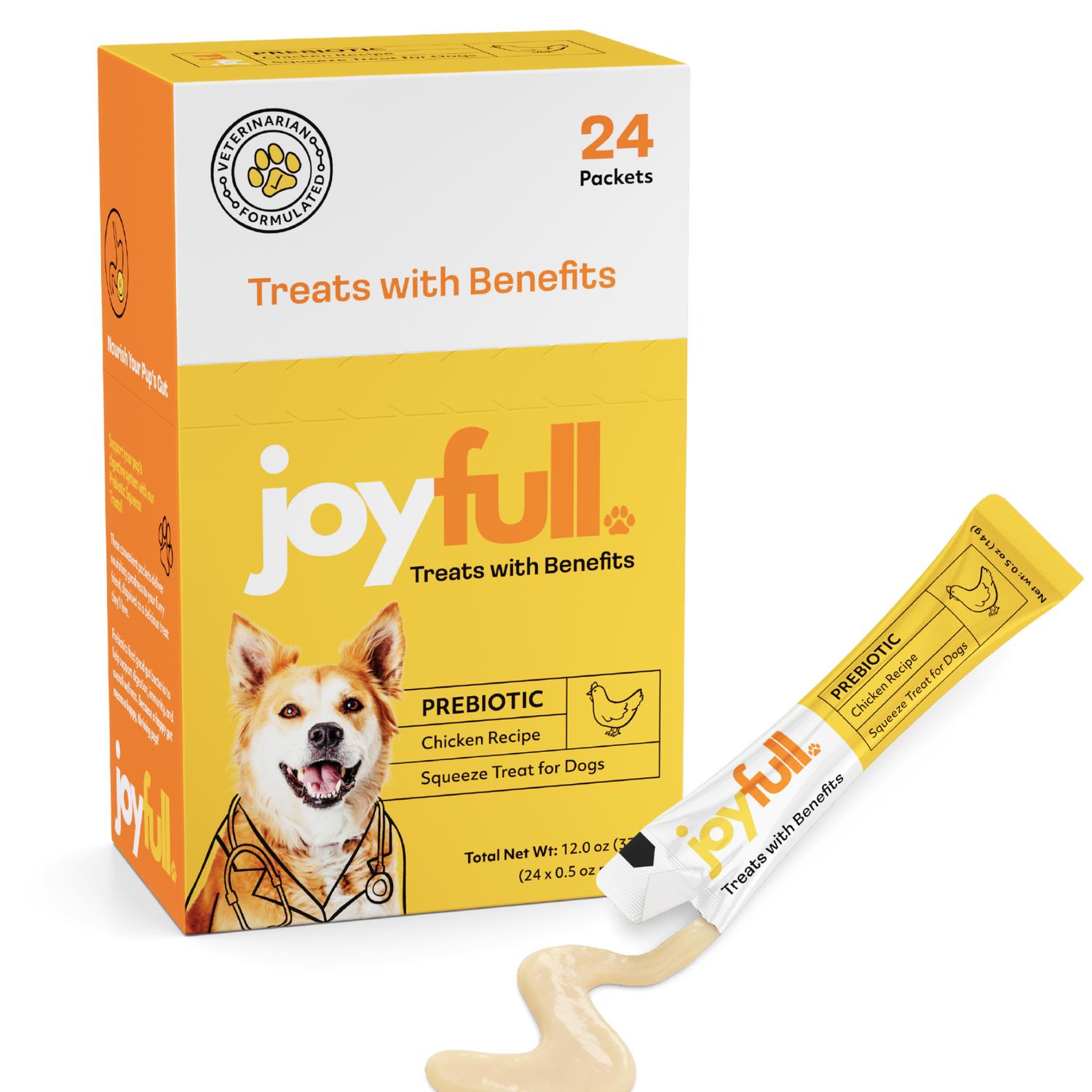
Healthy Snacks for Dogs Your Pup Will Love
When we talk about "healthy dog snacks," we're not just talking about boring diet food. The options are incredible these days, from simple, whole foods like carrots and blueberries to top-tier commercial treats packed with ingredients for specific health needs.
The real trick is learning to see past the flashy packaging and clever marketing. It's about finding snacks that genuinely boost your dog's wellness, not just give them a quick, empty-calorie fix.
Why Healthy Dog Snacks Are a Big Deal
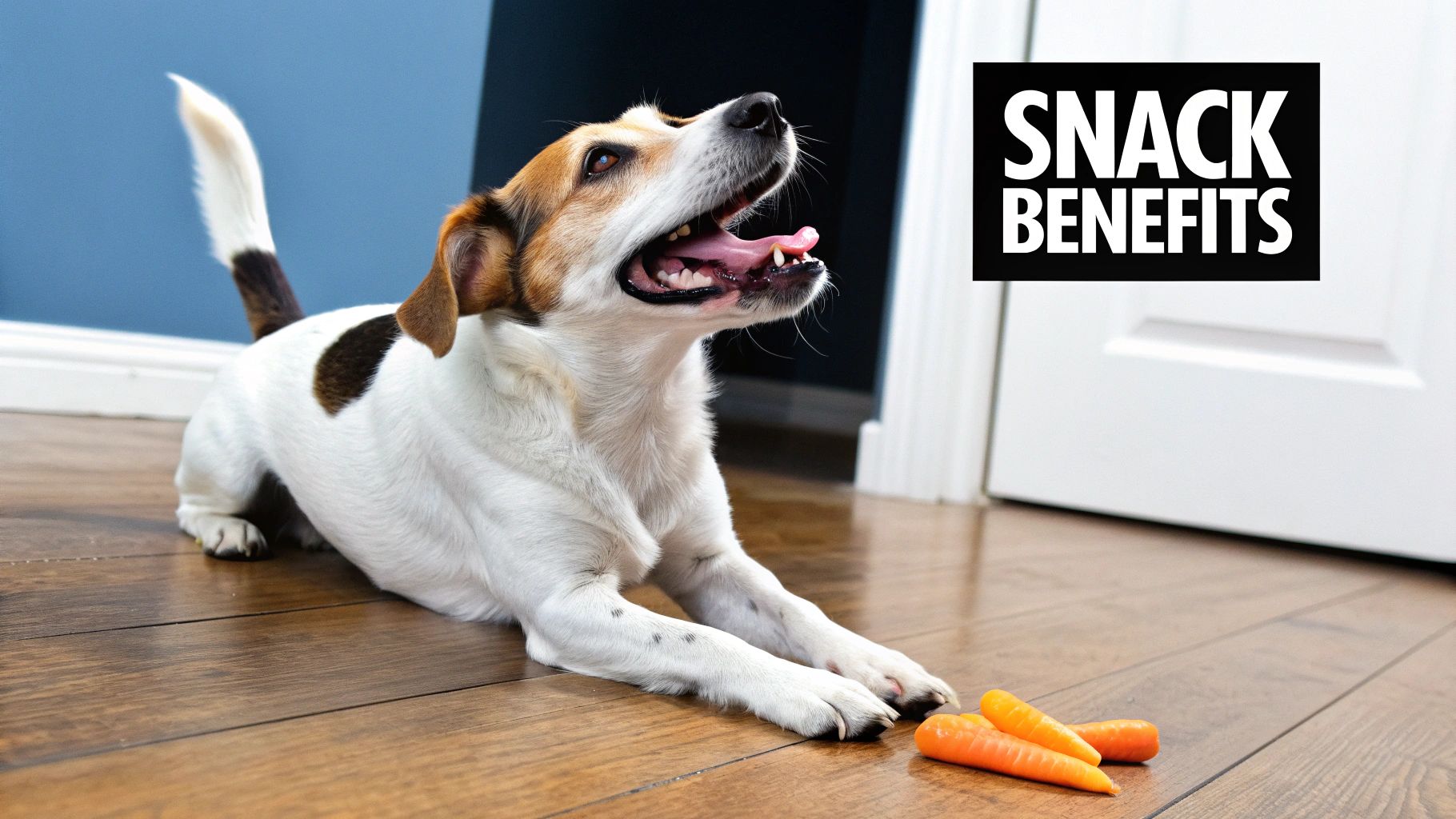
Let's be real—those puppy-dog eyes are practically a superpower. When your best friend gives you that look, handing over a treat feels like the most natural way to show them some love. But a good snack can be so much more than a tasty morsel; it’s a key piece of your dog's daily health and happiness.
Think of healthy snacks less like "junk food" and more like valuable tools in your pet-parent toolkit. They're perfect for positive reinforcement during training, helping you forge a stronger bond while teaching good manners. The right treat can also pull double duty by supporting specific health goals, whether that’s cleaning teeth or delivering a dose of essential vitamins.
The Modern Pet Parent's Perspective
Most of us don't see our dogs as just pets anymore—they're family. This simple shift in mindset has completely reshaped the pet food industry. We're long past the days of just grabbing any old colorful box off the grocery store shelf.
Today, dog owners are savvy. We want to know exactly what we’re feeding our companions, which means we’re on the lookout for snacks with ingredients we can actually recognize and trust.
This demand for quality is showing up in the numbers. The global market for dog food and snacks, valued at around $2.8 billion in 2025, is expected to jump to an incredible $4.4 billion by 2035. This boom is driven by people like us seeking out premium, organic, and grain-free options. You can read more about the evolving dog snack market trends to see just how much things are changing.
Choosing a healthy snack is a direct investment in your dog's long-term health. It moves beyond simply rewarding them and becomes an active way to contribute to their vitality and longevity.
Ultimately, this guide is here to help you cut through the noise. We'll give you practical, no-nonsense advice for picking and even making treats that your dog will go crazy for—and that will help you enjoy a long, vibrant life together.
How to Read a Dog Treat Ingredient Label
Walking into the pet food aisle can feel overwhelming. With so many bright packages and bold claims, how do you know what’s actually good for your dog? The secret is learning to become a label detective. Forget the flashy marketing on the front—the real story is always in the ingredient list on the back.
The first thing to know is that ingredients are listed by weight, starting with the heaviest. This means the first few items make up the majority of the snack. A top-quality treat will always have a real, identifiable protein source right at the top of that list.
Identifying Quality Ingredients
When you scan a label, your eyes should hunt for whole food ingredients you can easily recognize. Seeing words like "chicken," "beef," or "salmon" is an immediate green flag. These are specific, high-quality proteins.
On the flip side, vague terms are a major red flag. Descriptions like "meat and bone meal" or "animal by-product" are intentionally non-specific, often hiding lower-quality sources that manufacturers don't want to spell out. It’s the difference between a home-cooked chicken breast and a mystery-meat hot dog. You want to know exactly what your dog is eating.
The image below gives a great visual of simple, healthy ingredients and the benefits they bring to the table.
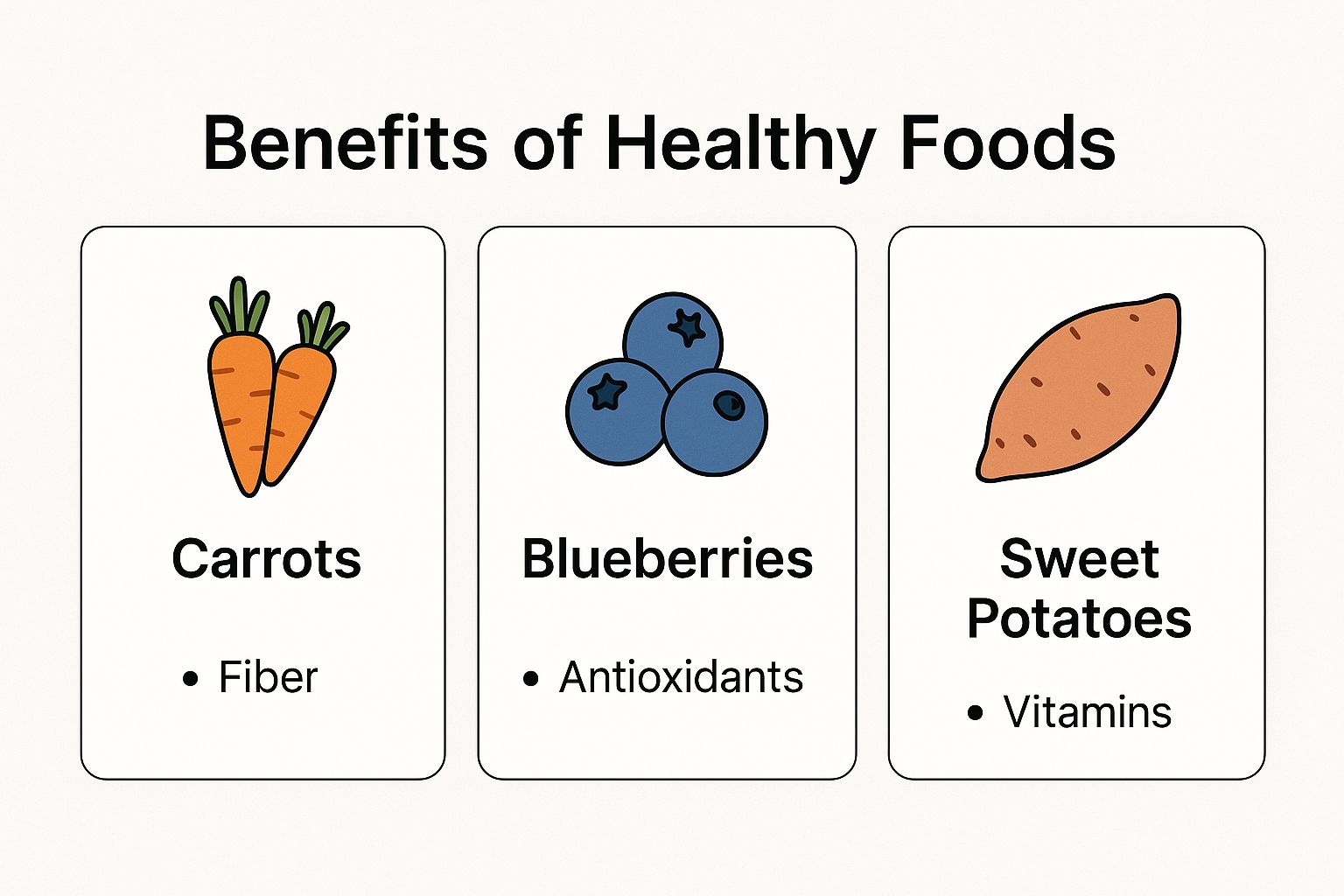
As you can see, even single ingredients like carrots, sweet potatoes, and blueberries pack a serious nutritional punch, making them fantastic choices for your dog's snack time.
Green Light vs Red Light Ingredients
A simple trick I use is a "Green Light, Red Light" mental checklist. Green Light ingredients are the good guys—whole, nutritious, and beneficial. Red Light ingredients are the ones to steer clear of, like cheap fillers, artificial junk, or things that are downright dangerous.
To make it even easier, I've put together a quick reference table. Think of it as your cheat sheet for the pet store aisle.
Green Light vs Red Light Ingredients in Dog Snacks
| Green Light Ingredients (Safe & Healthy) | Red Light Ingredients (Avoid) |
|---|---|
| Named Proteins: Chicken, lamb, turkey, beef, fish | Vague "Meat" Terms: Meat meal, animal by-products |
| Whole Fruits & Veggies: Pumpkin, carrots, blueberries, apples, sweet potatoes | Artificial Preservatives: BHA, BHT, ethoxyquin |
| Healthy Grains (in moderation): Oats, brown rice, barley, quinoa | Artificial Colors & Flavors: Red 40, Yellow 5, "bacon flavor" |
| Natural Preservatives: Tocopherols (Vitamin E), rosemary extract, ascorbic acid (Vitamin C) | Added Sweeteners: Corn syrup, sucrose, and especially xylitol (highly toxic!) |
| Healthy Fats: Fish oil, flaxseed, chicken fat (named sources) | Cheap Fillers: Corn, wheat gluten, soy, brewer's rice |
Looking at ingredients this way helps you quickly sort the premium snacks from the poor-quality ones. Your goal is to see a list dominated by the "Green Light" column.
You don't need to be a nutritionist to understand an ingredient panel. It's really about pattern recognition. If you prioritize identifiable, whole foods over vague, processed fillers, you're already making a much healthier choice for your dog.
It might feel a little tricky at first, but once you know the basics, you'll be able to make confident choices in minutes. If you want to get really good at this, our detailed guide on how to read dog food labels is the perfect next step. Mastering this skill empowers you to see past the marketing hype and pick treats that genuinely support your dog’s health and happiness.
Safe Human Foods You Can Share with Your Dog
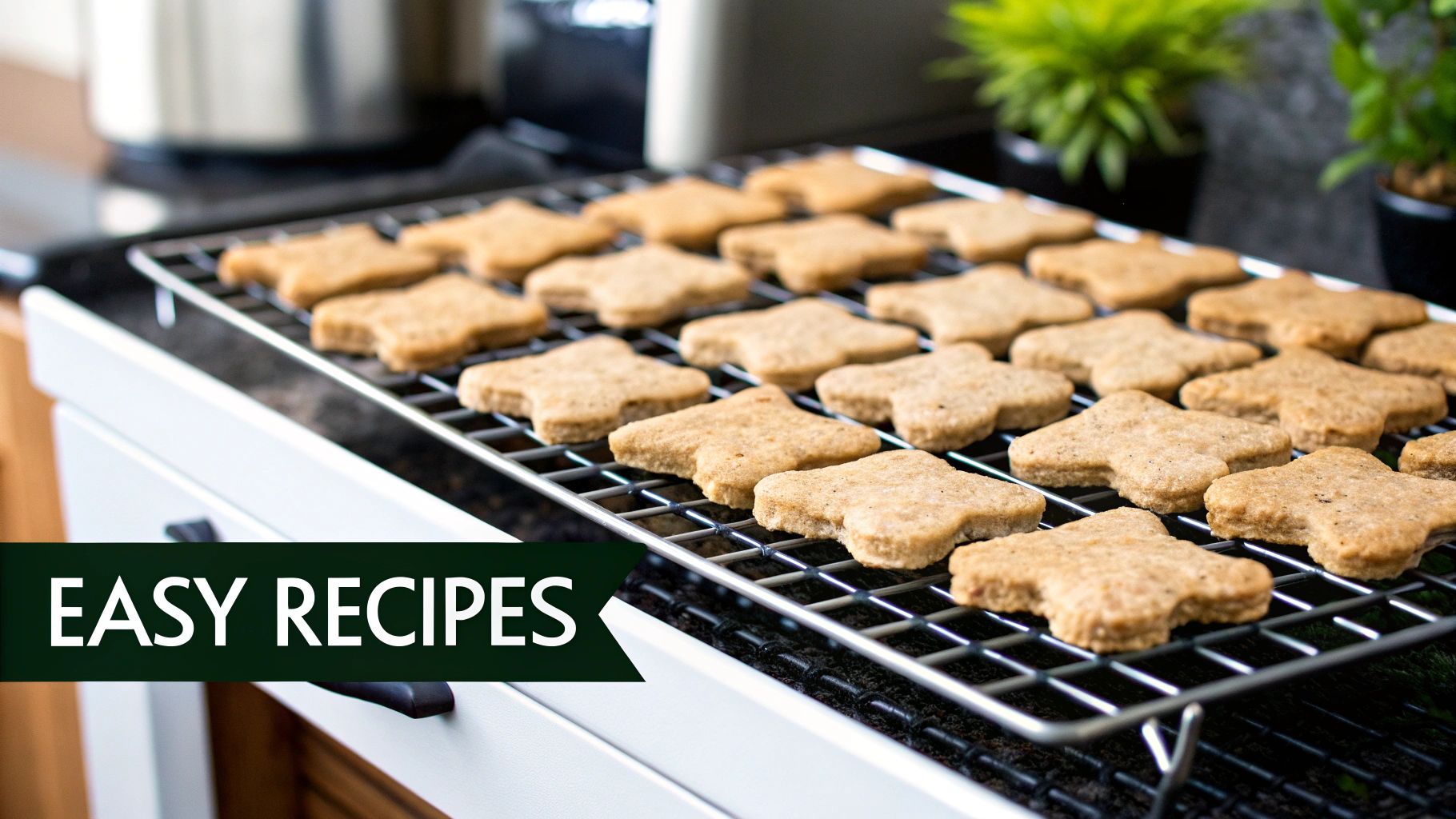
You know the look. You're slicing an apple or cooking chicken for dinner, and you feel a pair of hopeful eyes burning a hole through your soul. Sharing a bite is a simple act of love, but it’s vital to know which "people foods" are actually safe for your best friend.
The great news? Your kitchen is probably already full of fantastic, healthy options for your dog. Many fresh foods can supplement their diet with a boost of vitamins, fiber, and other nutrients that go way beyond what’s in their kibble. The trick is simply knowing what to pick and how to prepare it.
Nutrient-Rich Fruits and Veggies
Some of the best and easiest snacks to share come straight from the produce drawer. Think of veggies as low-calorie, high-fiber powerhouses that add a satisfying crunch to your dog's day while delivering a dose of vitamins for their overall health.
Fruits are another winner, offering natural sweetness and a punch of antioxidants. You just have to be a little more careful about the sugar content and always remove seeds, pits, and stems, as they can be choking hazards or even toxic.
Here are a few tried-and-true favorites you can feel good about sharing:
- Carrots: Low in calories and loaded with fiber and beta-carotene, carrots are fantastic for your dog's teeth and vision. Offer a raw baby carrot for a great crunch or serve them cooked for a softer treat.
- Green Beans: These are a wonderful source of iron and vitamins, making them a go-to low-calorie option, especially for dogs who need to watch their weight. Just be sure to serve them plain, with no salt or seasonings.
- Blueberries: Packed with antioxidants and Vitamin C, these little berries are amazing for supporting a healthy immune system. Their small size makes them the perfect, guilt-free training treat.
- Apples: Slices of apple offer a sweet, crunchy source of Vitamins A and C, plus a nice dose of fiber. Just make absolutely sure you remove the core and every single seed beforehand, as apple seeds contain trace amounts of cyanide.
- Pumpkin: Pure, canned pumpkin (the plain stuff, not the sugary pie filling!) is a miracle worker for digestive health. Its high soluble fiber content means a single spoonful can help firm up loose stool or get things moving.
When you're introducing any new food, always start with a tiny piece. Think of it as a taste test. This lets you watch for any allergic reactions or tummy troubles before you make it a regular treat.
Lean Proteins and Healthy Fats
It’s not just about fruits and veggies. Certain proteins and other wholesome foods can make incredible, high-value treats for your dog when they're prepared the right way. These pack in essential amino acids for muscle health and good fats for a shiny, healthy coat.
The number one rule here is to always serve proteins cooked and completely unseasoned. Ingredients we love, like onions, garlic, and too much salt, can be very harmful to dogs. Plain is always the safest—and best—way to go.
Consider adding these to your dog's snack rotation:
- Cooked Chicken or Turkey: As long as it's boneless, skinless, and simply boiled or baked without spices, lean poultry is a protein-packed reward that most dogs go crazy for.
- Cooked Salmon: Salmon is swimming in omega-3 fatty acids, which are fantastic for supporting healthy skin, a lustrous coat, and mobile joints. Make sure it's fully cooked through and has no bones.
- Eggs: A cooked egg is a nutritional powerhouse, offering easily digestible protein and amino acids. Scrambled or hard-boiled are both great—just skip the butter, oil, and salt.
- Peanut Butter: This is a classic for a reason, but you have to be vigilant. Always check the label and choose a natural, unsalted peanut butter that contains absolutely no xylitol. This common sugar substitute is extremely toxic to dogs.
Human Foods That Are Dangerous for Dogs
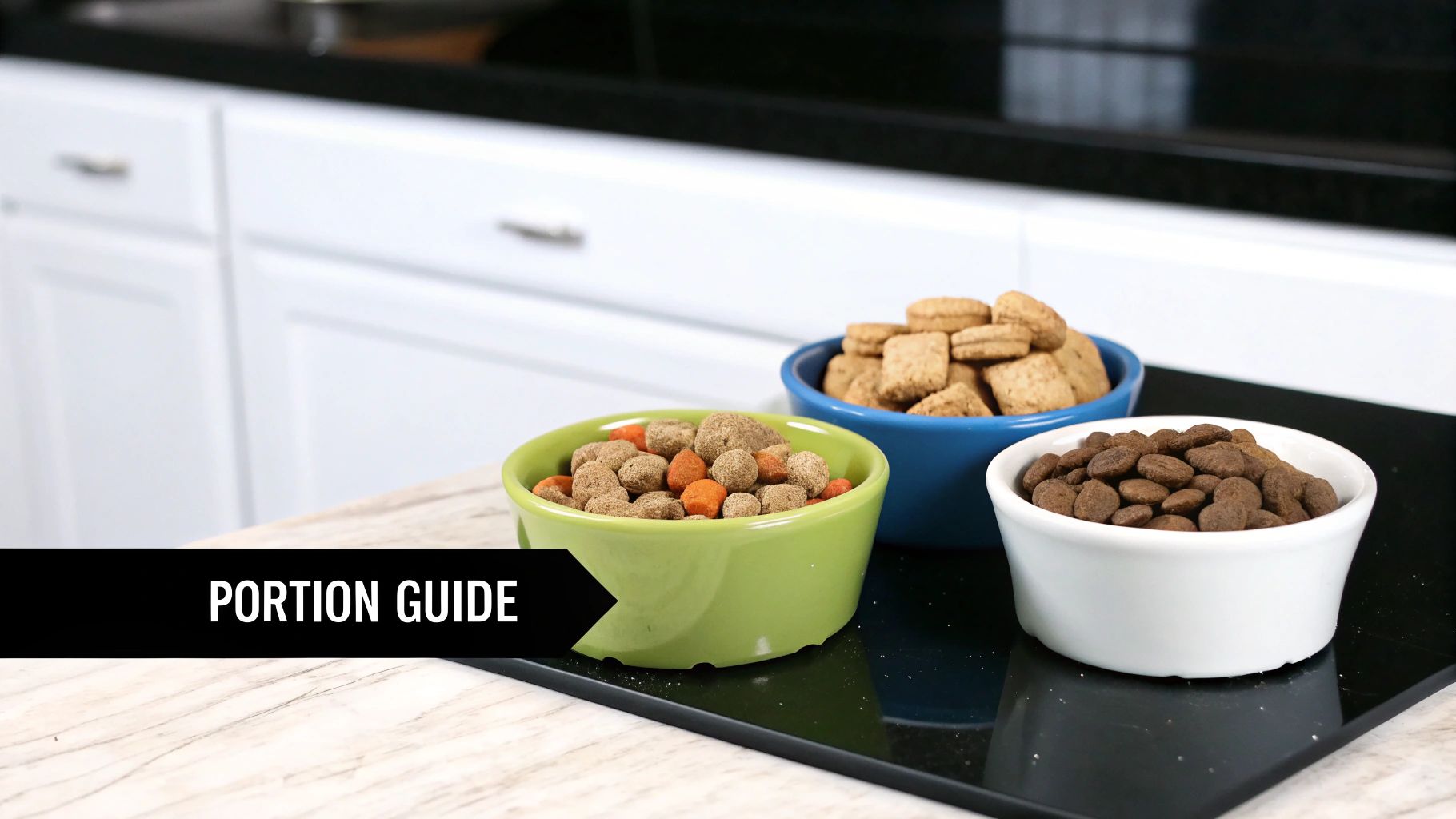
While it's fun to share our lives (and sometimes our plates) with our dogs, some of our favorite foods can be downright dangerous for them. Knowing what not to feed your pup is just as critical as picking out healthy treats. A seemingly harmless snack can quickly turn into an emergency vet visit, so it’s vital to know the risks.
Think of it this way: a dog's metabolism is fundamentally different from ours. What we can easily digest and enjoy might be toxic to them. This isn't about being overly protective; it's about understanding the real biological threats lurking in our own kitchens.
The Most Common Toxic Foods
Some of the biggest culprits are items you probably have in your pantry right now. Committing these to memory—and making sure everyone in the house is on the same page—is one of the most important things you can do for your dog's safety.
Here is a list of foods you should never let your dog get ahold of:
- Chocolate: This is the classic no-no for a reason. Chocolate contains compounds like theobromine and caffeine, which dogs can't metabolize properly. This can lead to anything from an upset stomach to seizures and heart failure. The darker the chocolate, the more dangerous it is.
- Xylitol: This sugar substitute is a huge red flag. It's found in countless sugar-free products like gum, candy, some peanut butters, and even baked goods. For dogs, it can trigger a catastrophic drop in blood sugar and lead to severe liver failure.
- Grapes and Raisins: It's bizarre but true—even a single grape or raisin can cause sudden, acute kidney failure in some dogs. We don't even know why they're so toxic yet, which makes it absolutely essential to keep them far away from your pet.
- Onions, Garlic, and Chives: Part of the allium family, these kitchen staples can wreak havoc on a dog’s red blood cells, causing a condition called anemia. It doesn’t matter if they’re raw, cooked, or powdered; they are all toxic.
It's not just about the food you hand over. A dropped onion slice during dinner prep or a raid on the kitchen trash can be just as deadly. Securing your pantry and garbage is a simple step that can prevent a true disaster.
We're all paying more attention to what goes into our pets' bodies, demanding natural and healthy snacks for dogs. It only makes sense to apply that same careful scrutiny to the foods they should never eat. If you're interested in learning more about these trends, you can discover more insights about the pet treats market and see how consumer awareness is changing the industry.
Easy Homemade Healthy Dog Treat Recipes
There’s something special about making treats for your dog right in your own kitchen. It's not just about saving a few bucks; it’s about knowing exactly what goes into their food. You get to skip all the mystery fillers and weird additives, serving up pure, wholesome goodness instead.
And you don't need to be a professional baker to pull it off. Most recipes call for simple, affordable ingredients you probably already have, like sweet potatoes, oats, and peanut butter (just make sure it's xylitol-free!). Let’s walk through a couple of my favorite go-to recipes that dogs absolutely love.
Classic Peanut Butter and Oat Biscuits
This one is a classic for a reason. It's simple, creates a satisfyingly crunchy biscuit, and is a surefire hit with almost every dog I've ever met. Plus, it delivers a nice little boost of fiber and protein.
Ingredients:
- 1 cup whole wheat flour (or oat flour if you're going grain-free)
- 1/2 cup rolled oats
- 1/2 cup xylitol-free peanut butter
- 1/2 cup hot water
Instructions:
- First things first, preheat your oven to 350°F (175°C) and get a baking sheet lined with parchment paper.
- In a medium bowl, mix the peanut butter with the hot water until it's smooth and creamy.
- Slowly stir in the flour and oats. Keep mixing until a stiff, workable dough forms.
- On a lightly floured surface, roll the dough out until it's about 1/4-inch thick. Now for the fun part—use cookie cutters to cut out your shapes!
- Place the biscuits on your prepared baking sheet and pop them in the oven for 20-25 minutes, or until they're perfectly golden brown.
- Let them cool completely before treating your pup. You can store them in an airtight container for up to two weeks.
Frozen Pumpkin and Yogurt Pupsicles
When summer rolls around and the pavement starts sizzling, these frozen "pupsicles" are an absolute lifesaver. They’re a fantastic way to help your dog cool down, and they’re also packed with probiotics from the yogurt and tummy-friendly fiber from the pumpkin.
Ingredients:
- 1 cup plain, unsweetened yogurt
- 1 cup pure pumpkin puree (make sure it's not the sugary pie filling!)
- 1 tablespoon of honey (this is optional, but adds a touch of sweetness)
Instructions:
- Grab a bowl and whisk the yogurt, pumpkin puree, and honey together until everything is nicely combined.
- Carefully pour the mixture into silicone molds or even just a standard ice cube tray.
- Freeze them for at least 4 hours, or until they're solid.
- When your dog needs a cool-down, just pop one out of the mold. Store the rest in the freezer for up to a month.
The real secret to great homemade treats is keeping it simple. Stick to ingredients you know are safe for dogs and always steer clear of salt, sugar, and especially artificial sweeteners like xylitol. Your dog's health always comes first.
Looking for more inspiration? We've got plenty of other creative ideas, from baked goodies to no-bake delights. Check out our full guide to homemade dog treats recipes to build up your baking skills. It’s such a fun way to show your dog some love and be confident they’re getting the very best.
How to Choose the Best Store-Bought Dog Treats
Let's be honest, walking down the dog treat aisle can feel overwhelming. With so many colorful bags and clever marketing claims, how do you sort the good from the junk? While whipping up homemade treats is great, we all need the convenience of a ready-to-go option sometimes.
The secret is learning to be a savvy label-reader. Your first mission? Find the shortest ingredient list possible.
If you can find treats that are single-ingredient or have very few ingredients, you’re on the right track. Think about things like freeze-dried salmon, simple sweet potato chews, or beef jerky strips. These kinds of snacks take the mystery out of what you’re feeding your dog, cutting out the nasty fillers and artificial junk.
Decoding Treat Types and Brands
Next, think about why you're giving your dog a treat. Is it a quick reward during a training session? Or is it something to keep them busy and help clean their teeth? Different treats serve different purposes.
- Training Treats: These should be tiny, soft, and low-calorie. The goal is to reward your dog often without throwing their daily calorie count way off.
- Dental Chews: Look for treats with a rough texture specifically designed to scrub away plaque and tartar. Bonus points if they have an endorsement from a veterinary dental organization.
- Long-Lasting Chews: Perfect for busting boredom and giving your dog’s brain a workout. Just make sure you pick the right size for your pup and always supervise them to prevent any choking hazards.
This shift toward functional, healthy treats isn't just a small trend—it's a massive movement. The global dog treats market is expected to explode from $44.2 billion in 2025 to an incredible $336.3 billion by 2035, all because pet parents are demanding real nutritional value. You can dive into the numbers in this comprehensive report.
Here's a pro tip: When you're checking out a new brand, look for transparency. Good companies are proud to tell you where their ingredients come from and how they make their products. If that information is buried or impossible to find, consider it a red flag.
By focusing on clear labels and purposeful ingredients, you can feel confident you're grabbing the best for your furry friend. For a deeper dive into what makes some snacks stand out from the pack, check out our guide on the healthiest treats for dogs.
Got Questions About Healthy Dog Snacks? We've Got Answers.
When it comes to treating your dog, it's easy to get bogged down with questions. You want to do what's best for your furry friend, but the advice can be confusing. Let's clear up some of the most common concerns about healthy snacks for dogs.
How Many Snacks Should I Give My Dog Each Day?
This is a big one. The go-to guideline here is the 10% rule. It's a simple but powerful principle: treats should never make up more than 10% of your dog's total daily calories.
Following this rule is the best way to prevent your dog from packing on unhealthy pounds while making sure their main meals are still delivering the balanced nutrition they need to thrive.
Of course, the actual number of treats will vary. It all depends on the snack's calorie count and your dog's unique profile—their age, weight, and activity level all play a role. If you're ever unsure, your vet is your best resource. They can help you calculate the perfect daily calorie target for your pup, taking all the guesswork out of the equation.
Think of your dog's daily food intake like a budget. Their main meals are the essential bills—rent, utilities—that must be paid first. Treats are the "fun money" left over, which should only be a small portion of the total.
Are Grain-Free Snacks Actually Better for Dogs?
Not always. "Grain-free" has become a huge marketing buzzword, but it doesn't automatically equal "healthier." In reality, unless your vet has specifically diagnosed your dog with a grain allergy or sensitivity, wholesome grains like oats and brown rice can be a great part of their diet.
What really matters is the overall quality of the ingredients. A snack that lists a high-quality protein as the first ingredient is always a better choice than a grain-free one filled with potatoes, peas, and other cheap fillers.
If you think your dog might have an allergy, skip the guesswork. Talk to your vet to get them properly tested before making any big changes to their diet.
At Joyfull, our mission is to make pet wellness simple and transparent. We craft our better-for-you snacks with clean ingredients and high-quality proteins, so you can feel confident in every treat you give. See our delicious and healthy options for yourself at the official Joyfull Pet website.
